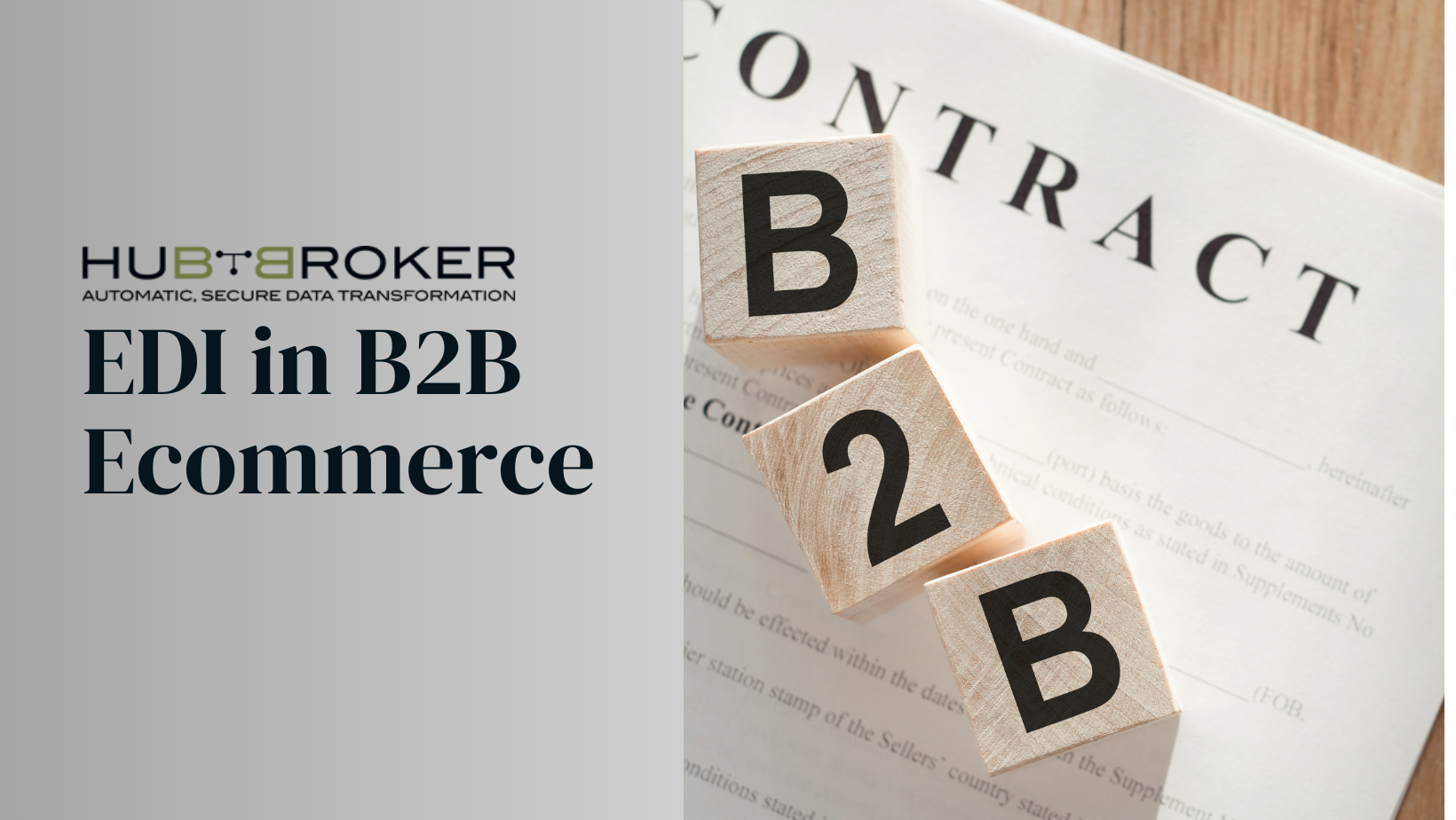Manufacturers and wholesalers seeking to modernize their sales processes often face a bewildering array of choices. It’s essential to remember that just because something is labeled a “solution,” it doesn’t guarantee it will address your specific challenges.
Previously, we delved into eProcurement and punchout catalog solutions, highlighting their distinctions from traditional eCommerce systems tailored for B2B companies. Now, let’s wrap up with a comparison between EDI (Electronic Data Interchange) and B2B eCommerce systems.
As reported by Digital Commerce 360, electronic data interchange stands out as one of the predominant digital sales channels, contributing to over 75% of digital B2B sales. In contrast, the B2B eCommerce channel accounts for approximately 13% of digital sales.
In this comprehensive guide, we’ll explore why EDI remains a preferred method for business data exchange. We’ll delve into the disparities between EDI and eCommerce, outline the advantages and limitations of each approach, and provide guidance on determining the most suitable option for your business needs.
Understanding EDI: Definition and Mechanism
Electronic Data Interchange (EDI) is a method enabling computers to exchange documents using predefined formats and digital protocols. It facilitates direct data transmission between companies without requiring intermediaries or additional processing.
EDI emerged as a solution to the challenge of document exchange between businesses. In essence, it streamlines data transfer processes, reducing errors and costs associated with manual handling.
In the realm of eCommerce, EDI simplifies transactions. For instance, if Company A intends to purchase widgets from Blue Widget Express, they create a Purchase Order (PO) sent directly to Blue Widget Express. Subsequently, Blue Widget Express generates a Sales Order and Invoice in response.
Unlike manual document creation prone to errors, EDI minimizes mistakes by leveraging computer-generated documents. Moreover, computer-to-computer data exchange proves significantly cost-effective compared to paper-based processing. Studies indicate that manual handling of paper orders can cost up to $70, whereas computer processing costs less than $1.
For EDI to function seamlessly, computers must adhere to compatible formats and architectures. This is where EDI’s role becomes crucial.
How EDI Operates
In a simplified breakdown of EDI’s operation:
- Configuring computers for data transfer via private communication networks is essential.
- EDI facilitates the transmission of various documents like purchase orders, invoices, shipping notices, and remittance letters between businesses.
- Documents are encrypted and transmitted securely.
- Upon receipt, data is decrypted, structured, and translated into a format the receiving system can interpret.
- The integrated data becomes part of the receiving system, and the process repeats to exchange data with the originating system.
By following these steps, EDI ensures efficient, error-free, and cost-effective data exchange, benefiting businesses across industries.

Businesses looking to streamline document sharing through Electronic Data Interchange (EDI) must first adopt one of several established EDI standards. These standards, such as ANSI, EDIFACT, TRADACOMS, and ebXML, define a specific format for the information within the document.
Typically, larger enterprises dictate the EDI standard they use and are often reluctant to adjust their EDI requirements. Consequently, smaller businesses must align with these standards to facilitate seamless transactions.
However, there are instances where EDI relationships can be tailored to accommodate unique pricing structures, fulfillment terms, and communication protocols.
To illustrate, let’s consider a practical scenario: Company A initiates a purchase order (PO) using the agreed-upon EDI standard and transmits it electronically to Blue Widget Express. Upon receipt, Blue Widget Express automatically processes the PO as an order, eliminating manual entry and potential human errors.
The order is then fulfilled, generating sales orders and invoices, which are electronically returned to Company A using the same standardized format. This streamlined approach allows Company A and Blue Widget Express to collaborate effectively without necessitating identical software systems, as long as they adhere to the mutually agreed-upon EDI standard for document exchange.
Is EDI Distinct from eCommerce?
EDI, or Electronic Data Interchange, is a method of conducting business electronically, making it a part of eCommerce technology. However, its primary focus is on transmitting documents rather than managing the entire buying and selling process.
An EDI system facilitates order placement, while an eCommerce platform not only accepts orders but also provides a comprehensive shopping experience, complete with a user-friendly front-end store.
To illustrate the contrast between EDI and eCommerce, consider this example: Suppose a buyer at Company A needs to purchase 600 units of SKU 148439 Tiny Aqua Widgets from Blue Widget Express. In this case, utilizing EDI for placing the order would be ideal.
However, if the buyer requires information about the Tiny Aqua Widget’s specifications, wants to compare it with other widgets, or is unsure about which widget to choose, EDI alone may not suffice.
Understanding the role of EDI in eCommerce involves comparing its advantages and use cases alongside those of traditional eCommerce platforms.
Comparing EDI and eCommerce
| Feature | EDI | eCommerce |
| Electronic ordering | Yes | Yes |
| Eliminates manual order entry | Yes | Yes |
| Perfect for repeat orders | Yes | Researching products and brand promotion, supports repeat orders |
| Product information included | No | Contains complete product information |
| Automating orders based on inventory levels | Excellent for this purpose | Provides cross-selling & upselling opportunities |
EDI vs eCommerce: Use Cases & Functions
| EDI | eCommerce |
| Manufacturer ordering/reordering raw materials | Manufacturer ordering supplies |
| Wholesaler ordering regular inventory | Wholesaler selling to distributors |
| Distributor ordering regular inventory | Distributors selling to retailers |
| Automating ordering based on inventory levels | Manufacturers/wholesalers selling direct |
Comparing EDI and B2B eCommerce: Making the Right Choice for Your Business
When it comes to B2B sales, both Electronic Data Interchange (EDI) and eCommerce offer distinct advantages. EDI allows orders to be processed efficiently without the need for direct sales rep involvement, making it ideal for customers who are familiar with the products they want. On the other hand, eCommerce platforms open up opportunities to reach new markets, upsell and cross-sell to existing customers, and provide a richer buyer experience with detailed product information. Additionally, eCommerce’s visibility on search engines can attract new buyers, while EDI excels at processing orders within established agreements. Ultimately, the choice between EDI and eCommerce depends on your business goals and target audience.
In general, EDI applications excel in the following areas:
- Swift and secure transfer of large data volumes.
- Seamless trading with partners having standardized or compatible systems.
- Cost-efficient handling of high-volume data transmissions.
- Reliable transfer of structured data like invoices and purchase orders.
- Automation of orders based on real-time stock levels.
- Compliance with supply chain requirements from major retailers and distributors.
On the contrary, B2B eCommerce is more suitable for:
- Educating buyers with comprehensive product catalogs including information, data sheets, images, and videos.
- Offering customers self-service options.
- Integrating seamlessly with existing business processes and systems.
- Enhancing online visibility.
- Exploring diverse selling models and boosting sales through cross-selling or upselling.
- However, relying solely on B2B eCommerce might limit advanced automation capabilities.
For companies with high-volume orders, EDI often proves superior to B2B eCommerce due to its direct computer-to-computer ordering based on inventory levels. While B2B eCommerce systems offer some automation, EDI provides a more streamlined approach.
Many B2B buyers expect EDI capability from their trading partners, prompting businesses to adapt their strategy to include EDI or risk missing opportunities.
Another vital aspect is integrating eCommerce and EDI with your ERP system. Both can integrate seamlessly, provided your chosen provider supports such digital integration.
What’s the Right Strategy?
An effective strategy typically combines digital solutions like eCommerce, EDI, and a B2B online portal. If your customers heavily rely on eProcurement systems, incorporating EDI or punchout catalogs can simplify their ordering and approval processes. However, it’s crucial not to rely solely on these solutions.
A Win-Win Approach: Integrating EDI into eCommerce
To thrive in digital commerce, providing B2B buyers with an optimal online shopping experience is key.
While EDI remains a staple for many B2B transactions, eCommerce is gaining traction. Combining both allows you to seize new opportunities while managing costs effectively.



